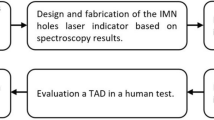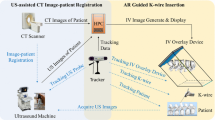Abstract
Purpose
Minimally invasive surgery is widely used for managing fractures; however, it is difficult to determine the exact screwing position of intramedullary nails inserted into bone. To address this problem, we developed the aiming and targeting system by laser (ATLAS) using two line lasers to mark the position of the surgical tool directly on the skin.
Methods
ATLAS consists of a laser module, controller, personal computer, and display device. The laser module is fixed to the intensifier side of the C-arm. Calibration with dedicated markers is required prior to using the system. After calibration, the laser modules can mark the selected point on a fluoroscopic image acquired with the C-arm as the intersection of the two line lasers on the skin.
Results
To verify the effectiveness of ATLAS, marking accuracy was measured. The average control error of the device itself was 0.57 mm. In the experimental setting using C-arm fluoroscopy, the accuracy was within 1.5 mm at 23 of the 25 measurement points and within 3 mm at the remaining two points.
Conclusion
ATLAS shows the corresponding points in real space with respect to fluoroscopic images using cross-points of lasers. The proposed method is clinically useful to aid the insertion of interlocking screws in minimally invasive surgeries for bone fractures. We believe that ATLAS enables more accurate marking through C-arm fluoroscopy and is more convenient, and it can thus be applied in various orthopedic surgeries.














Similar content being viewed by others
References
Kim JW, Kim JJ (2010) Radiation exposure to the orthopaedic surgeon during fracture surgery. J Korean Orthop Assoc 45(2):107–113. https://doi.org/10.4055/jkoa.2010.45.2.107
Krettek C, Mannß J, Miclau T, Schandelmaier P, Linnemann I, Tscherne H (1998) Deformation of femoral nails with intramedullary insertion. J Orthop Res 16(5):572–575. https://doi.org/10.1002/jor.1100160508
Krettek C, Könemann B, Miclau T, Schlandelmaier P, Blauth M, Tscherne H (1997) In vitro and in vivo radiomorphometric analyses of distal screw hole position of the solid tibial nail following insertion. Clin Biomech 12(3):198–200. https://doi.org/10.1016/s0268-0033(96)00069-1
Whatling GM, Nokes LDM (2006) Literature review of current techniques for the insertion of distal screws into intramedullary locking nails. Injury 37(2):109–119. https://doi.org/10.1016/j.injury.2005.09.009
Suhm N, Jacob AL, Nolte LP, Regazzoni P, Messmer P (2000) Surgical navigation based on fluoroscopy—clinical application for computer-assisted distal locking of intramedullary implants. Comput Aided Surg 5(6):391–400. https://doi.org/10.3109/10929080009148899
Suhm N, Messmer P, Zuna I, Jacob LA, Regazzoni P (2004) Fluoroscopic guidance versus surgical navigation for distal locking of intramedullary implants: a prospective, controlled clinical study. Injury 35(6):567–574. https://doi.org/10.1016/s0020-1383(03)00312-7
Lei H, Sheng L, Manyi W, Junqiang W, Wenyong L (2010) A biplanar robot navigation system for the distal locking of intramedullary nails. Int J Med Robot Comput Assist Surg 6(1):61–65. https://doi.org/10.1002/rcs.289
Wang T, Liu W, Hu L (2004) BPOR: a fluoroscopy-based robot navigating system for distal locking of intramedullary nails. In: 2004 IEEE/RSJ international conference on intelligent robots and systems, vol 4, pp 3321–3326. https://doi.org/10.1109/iros.2004.1389929
Malek S, Phillips R, Mohsen A, Viant W, Bielby M, Sherman K (2005) Computer assisted orthopaedic surgical system for insertion of distal locking screws in intra-medullary nails: a valid and reliable navigation system. Int J Med Robot Comput Assist Surg 1(4):34–44. https://doi.org/10.1002/rcs.54
Sasama T, Sugano N, Sato Y, Momoi Y, Koyama T, Nakajima Y, Sakuma I, Fujie M, Yonenobu K, Ochi T, Tamura S (2002) A novel laser guidance system for alignment of linear surgical tools: its principles and performance evaluation as a man—machine system. Int Conf Med Image Comput Computer-Assist Interv. https://doi.org/10.1007/3-540-45787-9_16
Nakajima Y, Yamamoto H, Sato Y, Sugano N, Momoi Y, Sasama T, Koyama T, Tamura Y, Yonenobu K, Sakuma I, Yoshikawa H, Ochi T, Tamura S (2004) Available range analysis of laser guidance system and its application to monolithic integration with optical tracker. Int Congress Computer-Assist Radiol Surg 1268:449–454. https://doi.org/10.1016/j.ics.2004.03.127
Liao H, Ishihara H, Tran HH, Masamune K, Sakuma I, Dohi T (2010) Precision-guided surgical navigation system using laser guidance and 3D autostereoscopic image overlay. Comput Med Imaging Graph 34(1):46–54. https://doi.org/10.1016/j.compmedimag.2009.07.003
Wong TH, Lee MS, Wu SY, Hsu W, Chung TK, Wu CP, Hsu PJ, Yang YS (2017) Novel passive two-stage magnetic targeting devices for distal locking of interlocking nails. J Healthcare Eng. https://doi.org/10.1155/2017/3619403
Uruc V, Ozden R, Dogramacı Y, Kalacı A, Dikmen B, Yıldız OS, Yengil E (2013) The comparison of freehand fluoroscopic guidance and electromagnetic navigation for distal locking of intramedullary implants. Injury 44(6):863–866. https://doi.org/10.1016/j.injury.2012.12.009
Hoffmann M, Schröder M, Lehmann W, Kammal M, Rueger JM, Ruecker AH (2012) Next generation distal locking for intramedullary nails using an electromagnetic X-ray-radiation-free real-time navigation system. J Trauma Acute Care Surg 73(1):243–248. https://doi.org/10.1097/ta.0b013e31824b0088
Chu W, Wang J, Young ST, Chu WC (2009) Reducing radiation exposure in intra-medullary nailing procedures: Intra-medullary endo-transilluminating (iMET). Injury 40(10):1084–1087. https://doi.org/10.1016/j.injury.2009.04.008
Başal Ö, Kırdemir V, Baykal B (2018) Accuracy of distal long femur nail locking with different techniques. Biomed J 10(3):7813–7816. https://doi.org/10.26717/bjstr.2018.10.001955
Acknowledgements
This work was supported by the Technology Innovation Program (No. 10063309, Development of high-precision modular restoration system for fracture reduction and bone deformity correction) funded by the Ministry of Trade, Industry & Energy (MOTIE, Korea).
Author information
Authors and Affiliations
Corresponding author
Ethics declarations
Conflict of interest
The authors declare that they have no conflict of interest.
Ethical approval
All applicable international, national, and/or institutional guidelines for the care and use of animals were followed.
Informed consent
For this type of study, formal consent is not required.
Additional information
Publisher's Note
Springer Nature remains neutral with regard to jurisdictional claims in published maps and institutional affiliations.
Rights and permissions
About this article
Cite this article
Yu, J., Song, H., Park, Cw. et al. Fluoroscopic images-based aiming and targeting system with two line lasers for insertion guidance of interlocking screw. Int J CARS 15, 1001–1012 (2020). https://doi.org/10.1007/s11548-020-02196-x
Received:
Accepted:
Published:
Issue Date:
DOI: https://doi.org/10.1007/s11548-020-02196-x




